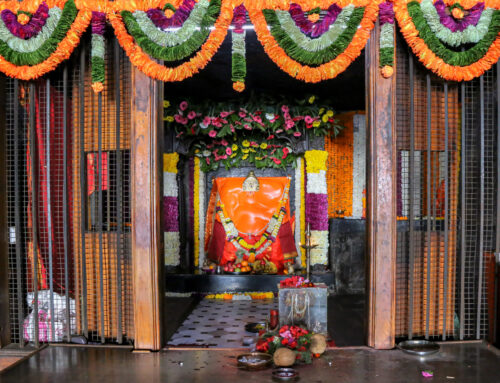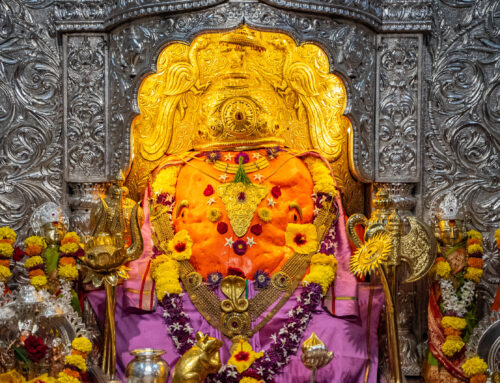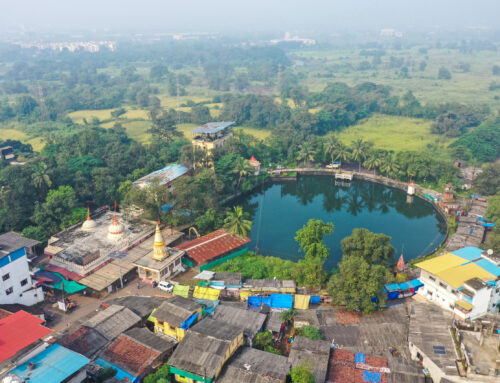“Ganpati Bappa morya, mangalmurti morya” – when we chant this, the image of a benevolent God comes to mind, one who is loved and respected by all. Lord Ganesha, son of Lord Shiva and Parvati Devi is the foremost revered god in the Hindu pantheon. Legend has it that Parvati Devi ensured that her dear son will always be the god to be worshipped first, before everyone else. Belief is, if you don’t invoke the blessings of Ganesha or Ganapati then your puja will be incomplete and prayer will go unanswered. Lord Ganesha is worshipped all over India but in Maharashtra, the tradition of Ganesha worship is very important and has a rich history associated with it. There are numerous famous Ganesha temples scattered all over Maharashtra but the Ashtavinayak mandirs or the eight Ganesha temples have a special significance and devotees believe that darshan of all the eight temples will bring good fortune and happiness to their lives. The Ashtavinayak temples are situated surrounding Pune city, 5 in Pune district, 1 in Ahmednagar district and 2 in Raigad district.
These temples are ancient and for quite a few of them, the exact date of establishment is unknown. Sacred Hindu texts like Skanda Purana, Mudgala Purana and Tamil Vinayak Purana talk of the origin of these shrines dedicated to “the remover of obstacles” or “the giver of intelligence & competence”. The pilgrimage to the Ashtavinayak mandirs should ideally follow a particular order – starting with Mayureshwar Temple (Morgaon), Siddhivinayak temple (Siddhatek), Ballaleshwar temple (Pali), Varada Vinayak temple (Mahad), Chintamani temple (Theur), Girijatmaj temple (Lenyadri), Vighneshwar temple (Ozar), Mahaganapati temple (Ranjangaon) and finally a revisit to Morgaon temple. The entire journey covers about 654 km and pilgrims try to cover the circuit in 1 or 2 days.
Let’s delve a little further into the fascinating stories and legends behind these temples which have drawn thousands of devotees to these places since time immemorial.

Moreshwar Ganapati temple, Morgaon
The most important of the Ashtavinayak temples, Moreshwar or Mayureshwar is situated in Baramati taluka, about 55 km from Pune. The Morgaon village, on the banks of Karha river has got its name from its shape which is said to resemble a peacock. Legend says that at this spot Lord Ganesha had slayed the demon Sindhurasur. The original idol is said to be made of atoms of sand, iron and diamonds and the Pandavas had enclosed it inside a copper sheet and it is placed behind the present idol. The Ganapati idol at this temple has its trunk turned leftwards with an image of Nagaraja or a cobra guarding over it. Interesting fact about this temple is its architecture which resembles a mosque with minarets. The probable explanation is that it was done purposely to evade attacks by Muslim invaders.

Siddhivinayak temple, Siddhatek
The only Ashtavinayak temple in Ahmednagar district, it is situated 48 km away from the town of Srigonda, just beside the Bhima Nadi. Siddhatek holds a lot of religious significance because it is believed that Lord Vishnu attained Siddhi here and also vanquished the asuras named Madhu & Kaitabh after getting the blessings of Ganapati. In later times, Saint Morya Gosavi and Shri Narayan Maharaj of Kedgaon are also believed to have received divine enlightenment at this place. The unique feature of this temple is that, the trunk of Lord Ganesha is turned towards his right, on the side where his wife Siddhi resides. Here from originates the name Siddhivinayak. The inner sanctum of the temple was built by Queen of Indore, Ahilyabai Holkar while the main road leading to the temple was built by Peshwa’s General Haripant Phadake. The worship of Siddhivinayak incarnation of Ganesha is very strict and devotees must adhere to the Vedic rules of puja, otherwise the deity is displeased. Even to make one pradakshina of the temple, the devotees have to take a round of the entire hill on which the temple is located. The festivals of Ganesh Jayanti, Vijayadashami & Somvati Amavasya see a lot of footfall at this temple.
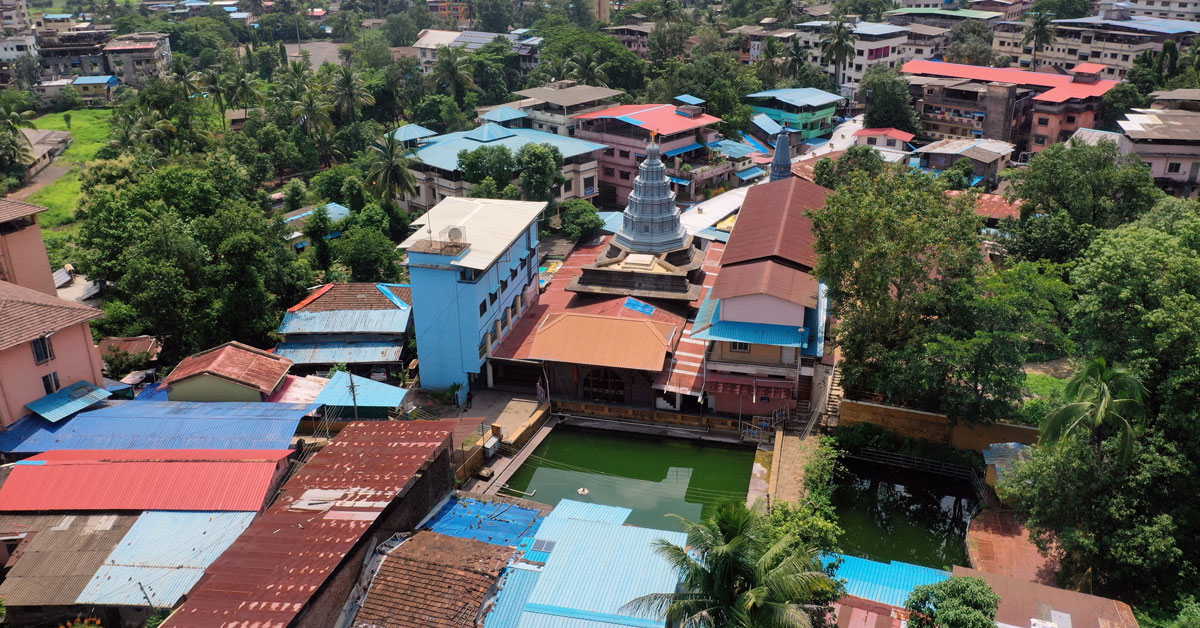
Ballaleshwar temple, Pali
It is one of the Ashtavinayak temple, About 120 km away from Pune and 28 km ahead of Roha in Raigad district is the small village of Pali. This is the only temple where Ganapati is known by the name of his devotee. Ballal was a young and ardent devotee of Lord Ganesha and moved by his unwavering devotion despite facing a lot of torment, Ganesha decided to reside forever at this place and came to be known as Ballaleshwar. Apart from the main idol, there is another stone idol called “Dhundi Vinayak” who is worshipped before.
The idol in the sanctum faces east and is placed in such a way that after Dakshinayan, the morning rays of the sun fall on the idol. The orange sindur smeared stone idol has diamonds, rubies and other precious jewels studded on it and the trunk is turned leftwards. The specialty of this temple is that besan laddu is offered as prasad instead of modak. The temple was designed by Moreshwar Vitthal Sindkar in 1640, later the wooden temple was replaced with a stone temple by Shri Fadnavis in 1760. To get Virtual Darshan of Shri Ballaleshwar, Pali – Click Here

Varada Vinayak temple, Mahad
This temple is located near the hill station of Karjat in Khalapur taluka. The temple was renovated by Ramji Mahadev Biwalkar in 1725 AD. The legend regarding the origin of the temple is quite interesting. The childless King Bhima of Koudinyapur and his queen were blessed by Maharshi Vishwamitra to have a son whom they named Rukmagandha. Once on a hunting trip, the handsome prince met Rishi Vachaknavi’s wife Mukunda who fell in love with him. The prince refused the illicit call of Mukunda and by deceit God Indra bore a child to Mukunda who was named Gritsamada. When Gritsamada learnt about the story of his birth, he cursed his mother to become the thorny tree called “bhor” and in return his mother cursed him saying that a cruel demon will be born from him. After this unfortunate incident, Gritsamada went into the forest and worshipped Lord Ganesh who was appeased. This led him to establish the temple of Varada Vinayak which we see today. The temple is east facing and the swayambhu Ganapati idol is left trunked. This is the only temple where devotees are allowed to enter the sanctum and offer puja to Ganapati. Maghi Chaturthi is a special festival here and it is believed that Lord Ganesha fulfills all wishes during this time.

Chintamani Temple, Theur
Chintamani temple, Theur 22 km away from Pune, off the Pune-Sholapur highway lies the ancient Chintamani temple, at the confluence of the Mula, Mutha and Bhima rivers. The legend associated with this temple is described in Mudgala Purana, that a greedy prince called Guna or Gana had once stolen the wish granting Chintamani jewel from sage Kapila. Finding no way to retrieve the jewel, Rishi Kapila beseeched Lord Ganesha, who waged a battle with Guna, defeated him and brought back the jewel. But Kapila didn’t take the jewel back, instead gifted it to Ganapati and requested him to stay at that place. Another legend says that Ganapati in the form of Chintamani Ganapati had pacified the restless mind of Lord Brahma at this place, hence the temple came into being.
Chintamani temple has historical significance as Peshwa Madhavrao I was a patron and frequent visitor to the temple. The original temple had been built by Ganpatya saint Morya Gosavi and later renovated by Madhavrao I. Chintamani Ganapati is believed to give peace of mind and remove all restlessness amongst his devotees. The idol is smeared with sindur and sits in a cross-legged position with jewels studded on the surface. The three main festivals celebrated here are Ganesha Prakatotsav (Ganesh Chaturthi), Maghotsav & Rama-Madhav Punyotsav (celebrating the great devotees Madhavrao I and his wife Ramabai).

Girijatmaja temple, Lenyadri
This is the only Ashtavinayak temple which is situated on a hill. About 5km north of Junnar town is Lenyadri hill or Ganesh Leni as it is sometimes called. The site of the temple is originally a complex of Buddhist caves dating to 1st to 3rd century AD. The Hinayana Buddhist caves comprise of viharas and chaitya grihas numbered from one to twenty six. Cave 7 is the Ganapati temple but nobody knows when and how this Buddhist cave transformed into a Hindu temple. However, this temple has a very famous legend associated with it. It is believed that Lenyadri is the place where Devi Parvati practiced austerities which led to her becoming the mother of Ganesha, making it his birthplace. Girijatmaja translates into son of Girija, meaning Devi Parvati. The irregularly carved stone idol has a leftward bent trunk and only one of his eyes is visible. The idol has originated from the wall of the cave itself and during Peshwa rule it was covered in a wooden armour plated with brass. The occasions of Ganesh Jayanti and Ganesh Chaturthi are celebrated here.
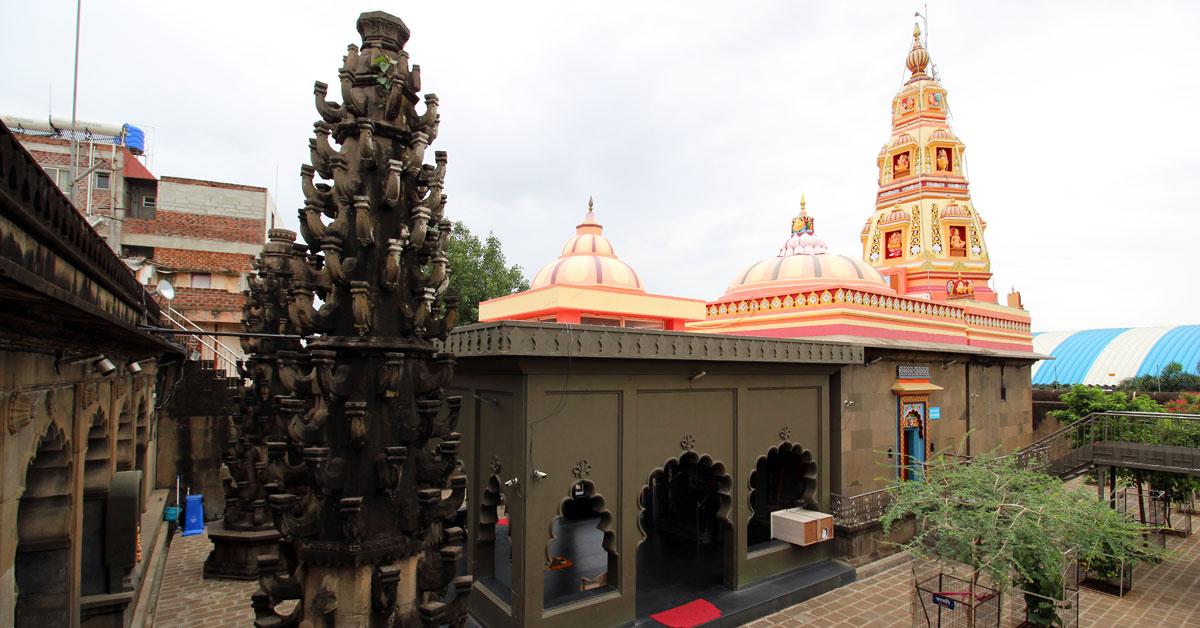
Vighnahar or Vighneshwar temple, Ozar
To the north of Pune, in Junnar taluka is situated the Vighnahar temple on the banks of the Kukadi river. There was once an asur or demon called Vignasur whose job was to create obstacles in all activities. He had been appointed by Lord Indra to ruin the yagna of King Abhinandana as the latter had not made any offering to Indra. Vignasur went a step further and started meddling in the religious & spiritual pursuits of sages and other people. It was at this time that Lord Ganesha was requested to intervene. He defeated the demon and made him promise that he will never trouble the devotees of Ganesha and only be present at places where Ganapati was not revered. Till today, this form of Ganesha is believed to remove obstacles and problems from the lives of the devotees.
The temple spire was decorated with gold by Chimaji Appa after he conquered the Vasai fort. The idol is decorated with diamonds, rubies and other jewels and the images of Riddhi and Siddhi who are believed to be the consorts of Ganesha are seen on either side. To get Virtual Darshan of Shri Vighneshwar, Ozar – Click Here AND To get Virtual Aarti of Shri Vighneshwar, Ozar – Click Here

Maha Ganapati temple, Ranjangaon
On the Pune-Nagar road, about 50km away from Pune city is situated the town of Ranjangaon. The Ashtavinayak form here is known as Maha Ganapati and is said to be the fiercest and most powerful form of the god. Legend has it that once Lord Shiva had to battle a super powerful demon called Tripurasur whom he could not vanquish easily. At this point, Shiva prayed to Ganesha who helped him defeat Tripurasur. Subsequently this temple was built at the spot where Lord Shiva had prayed. Popular belief is that there is another idol called “Mahotkat” having 10 trunks and 20 hands which is hidden in a basement chamber of the mandir. The idol of Maha Ganapati is east facing, seated on a lotus and his consorts Riddhi and Siddhi are seen on either side. This temple marks the end of the Ashtavinayak yatra.
The Ashtavinayak yatra is not just a religious experience, it is also a tryst with the history, culture & faith of the land. It has been on the pilgrimage itinerary of Ganesha devotees since time immemorial but in the present scenario when venturing out of the house is no easy task, we have brought for you the opportunity of experiencing a visit to the temple while sitting safely at home. With our advanced photography and state of the art technology we have created a virtual darshan of the temple here (link to the virtual darshan) so that we can transport you to the sanctum, right in front of your beloved Lord Ganapati. You can also watch the arati at the temples and I’m sure you’ll get the blessings of the Lord even though you are sitting far away from his temple.

